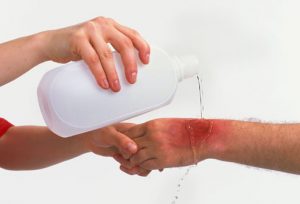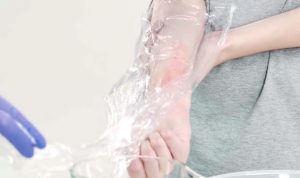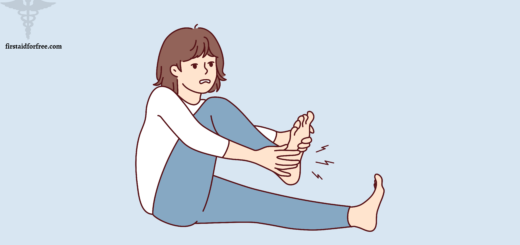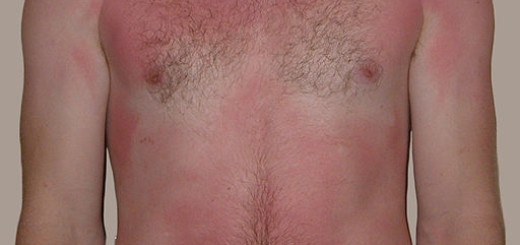First Aid for Minor Burns
Minor or first degree burns are incredibly common household injuries. Our homes are full of items which can cause burns – hair straighteners, kettles, toasters, electric heaters. The list is endless!
Generally, burns are caused by touching something hot which damages the top layer of skin or epidermis. However, they can also be caused by radiation (for example, from the sun), chemicals, electricity and friction.
As well heat, burns can also be caused by the extreme cold – these are known as freeze or ice burns.
In this first aid blog post we will discuss the correct first aid treatment for minor burns.
Different Degrees of Damage Caused by Burns
The following are the different degrees of damage caused by different degrees of burns:
- First-degree burns: First-degree burns are the burns that affect only the skin’s outer layer, known as the epidermis. The burn site gets dry, painful, and red, and doesn’t lead to blisters.
- Second-degree burns: Second-degree burns cause damage to both the skin’s outer layer as well as the second layer, which is known as the dermis. Blisters can develop after such burns, and the burns could lead to scarring. Your skin will appear swollen, bright red, wet, and shiny.
- Third-degree burns: Third-degree burns, which are also referred to as full thickness burns, destroy the epidermis and all the layers of a person’s skin. The burned areas usually appear black, white, yellow, or brown. These don’t cause pain as such burns damage the nerve endings.
Treating a minor burn
Step 1: Immediately run the burn under cold running water for a minimum of 20 minutes. If running cold water is not available then improvise! You can use other non-toxic liquids such as drinks. Your aim is to cool the burn.
Step 2: Expose the affected area and if possible remove anything that could be constricted (watches, jewellery etc.). Do not remove clothing sticking to the burn, instead cool through the clothing.
Step 3: After cooling the burn, cover with a non-fluffy dressing/covering. If you have access to a first aid kit, use a non-fluffy sterile dressing. If not then improvise with whatever is available (plastic bag, kitchen clingfilm, teatowel etc.). As the top layer of skin has been damaged by the burn, adding a cover protects against infection from the outside world getting in. Be careful not to constrict the burn!
Step 4: Seek medical advice for anything except the most minor of burns. Call an ambulance if serious or if the burn is near the face/neck. When it comes to burns, there are lots of ‘housewifes tales’ and home-made remedies, in general however you should not:
- Apply toothpaste/butter/spread/anything else to the burn
- Burst blisters (however tempting!)
- Apply adhesive dressings or plasters
The reason behind the top one is that cool running water is the most effective method to cool a burn, not anything else. However for sunburn, you can apply an after-sun lotion as this will help cool & sooth the burn.
To refresh your knowledge on the different types of burn check out our classification of burns blog post here, or visit our first aid tips for treating other types of burns and scalds.
Want to learn more first aid skills? Sign up to one of our free online first aid courses to improve your first aid knowledge.
Aftercare for Minor Burns
Once the burn cools down, the first thing to do is to ensure whether it’s a minor burn or not. In case it is a larger or deeper burn or if it’s located on the patient’s wrist, elbow, shoulder, ankle, knee, hip, groin, foot, face, hand, or buttocks, then they will require immediate medical attention.
The aftercare for minor burns is as follows:
- Gently clean the burn using water and soap.
- Do not break the blisters as an open blister could get infected.
- A thin layer of ointment can be applied on the burn, such as aloe vera or petroleum jelly. It’s not necessary for the ointment to have antibiotic properties as certain antibiotic ointments may cause allergies. Make sure to not apply butter, oil, lotion, cream, egg white, or cortisone on the burn.
- Keep the burn protected from pressure and the movement of rubbing, if required, by making use of a sterile non-stick gauze. Lightly tape it or wrap it over the burn. Make sure that the dressing isn’t of the kind that will shed fibers, as those can get caught in the burn.
- Remember to change the dressing once a day.
- Take over-the-counter pain medication, such as aspirin, naproxen, ibuprofen, or acetaminophen. If the person who has suffered a minor burn is a child under the age of 2 or someone who is 18 or younger or if they are recovering from chickenpox or symptoms of flu, don’t give them aspirin.
When to Call the Doctor
Burns are vulnerable to tetanus. Therefore, tetanus bacteria can get inside the patient’s body through the burn. Get in touch with your healthcare provider in case it has been over five years since your last tetanus shot, as you may require a booster shot.
Call your doctor if you witness these following signs of infection:
- Increased pain
- Fever
- Swelling
- Swollen lymph nodes
- Redness
- Pus or oozing
- Red streak as a result of the burn
FAQs
Do minor burns heal quickly?
Minor burns usually take a week to heal and don’t leave behind any scars
Can I shower with a burn?
A cool shower is ideal once you have suffered a burn.
Can I put ice on a burn?
Using ice on a burn is not recommended at all as it can damage the tissue even further.
Can I put aloe on a burn?
Yes, aloe vera is a very popular go-to element for the treatment of burns as it helps in reducing inflammation and pain.
Yes, aloe vera is a very popular go-to element for the treatment of burns as it helps in reducing inflammation and pain.
Conclusion
When someone has a minor burn, it can take up to three weeks for the burn to heal. A burn can get pretty itchy during the healing process, but it’s important to remember to never scratch it.
The deeper a burn is, the higher are the chances of scarring. If you feel your burn is leading to a scar, get in touch with your healthcare provider right away.








I went thro this with my wife first hand – *I did all the right steps too
Great stuff Ralph!
– John